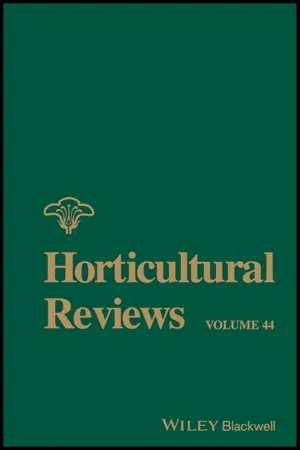
This is a test
- English
- ePUB (mobile friendly)
- Available on iOS & Android
eBook - ePub
Horticultural Reviews, Volume 44
Book details
Book preview
Table of contents
Citations
About This Book
Horticultural Reviews presents state-of-the-art reviews on topics in horticultural science and technology covering both basic and applied research. Topics covered include the horticulture of fruits, vegetables, nut crops, and ornamentals. These review articles, written by world authorities, bridge the gap between the specialized researcher and the broader community of horticultural scientists and teachers.
Frequently asked questions
At the moment all of our mobile-responsive ePub books are available to download via the app. Most of our PDFs are also available to download and we're working on making the final remaining ones downloadable now. Learn more here.
Both plans give you full access to the library and all of Perlego’s features. The only differences are the price and subscription period: With the annual plan you’ll save around 30% compared to 12 months on the monthly plan.
We are an online textbook subscription service, where you can get access to an entire online library for less than the price of a single book per month. With over 1 million books across 1000+ topics, we’ve got you covered! Learn more here.
Look out for the read-aloud symbol on your next book to see if you can listen to it. The read-aloud tool reads text aloud for you, highlighting the text as it is being read. You can pause it, speed it up and slow it down. Learn more here.
Yes, you can access Horticultural Reviews, Volume 44 by Jules Janick, Jules Janick in PDF and/or ePUB format, as well as other popular books in Biological Sciences & Botany. We have over one million books available in our catalogue for you to explore.
Information
1
Identification of Phytomorphs in the Voynich Codex
Arthur O. Tucker
Department of Agriculture and Natural Resources, Delaware State University, Dover, DE, USA
Jules Janick
Department of Horticulture and Landscape Architecture, Purdue University, West Lafayette, IN, USA
ABSTRACTThe Voynich Codex, one of the most fascinating and bizarrely illustrated manuscripts in the world, is preserved in the Beinecke Rare Book and Manuscript Library of Yale University. The descriptive text seems to be an undeciphered writing system. The manuscript has been divided into sections by Voynich commentators, with the major portion of the manuscript depicting plant, animal, and geological images. About 362 phytomorphs, 20 zoomorphs, and 1geomorph are included. In 1944, Hugh O'Neill, a distinguished taxonomic botanist at the Herbarium of the Catholic University of America in Washington, DC, identified two Mesoamerican plants, indicating the possibility that this manuscript is post-Columbian. These identifications were expanded by Tucker and Talbert (2013) to include 37 plants of Colonial New Spain. This paper extends these identifications to 59 phytomorphs, encompassing 55 plant species. Phytomorphs were analyzed by comparing the morphology of the botanical illustrations with herbarium specimens, photographs, and contemporary sources of live plants. The 55 plant species, identified with various levels of certainty, are either circumboreal or indigenous to Colonial New Spain. Most appear to have medicinal uses to improve human health. No European, Asian, or South American plants have been identified other than circumboreal species. This study is consistent with the determination that the Voynich Codex is a herbal written in Colonial New Spain in the 16th century.
KEYWORDS: Aztec; botany; Colonial New Spain; herbal; Mexico; plant taxonomy; Voynich Manuscript
- I INTRODUCTION AND HISTORICAL CONTEXT
- II PHYTOMORPH IDENTIFICATION
- A Fern: Ophioglossaceae
- 1. Fol. 100v #5. Ophioglossum palmatum (Fig. 1.1)
- B Gymnosperm: Taxodiaceae
- 1. Fol. 100r #15. Taxodium sp., cf. T. mucronatum (T. huegelii, T. mexicanum)? (Fig. 1.2)
- C. Angiosperms: Asparagaceae/Agavaceae
- 1. Fol. 100r #4. Agave sp., cf. A. atrovirens (Fig. 1.3)
- D. Apiaceae
- 1. Fol. 16v. Eryngium sp., cf. E. heterophyllum (Fig. 1.4)
- E. Apocynaceae
- 1. Fol. 100r #14. Gonolobus chloranthus (Fig. 1.5)
- F. Araceae
- 1. Fol. 100r #2. Philodendron mexicanum (Fig. 1.6)
- 2. Fol. 100r #7. Philodendron sp. (Fig. 1.7)
- G. Asteraceae
- 1. Fol. 53r. Ambrosia sp., cf. A. ambrosioides (Fig. 1.8)
- 2. Fol. 93r. Helianthus annuus (Fig. 1.9)
- 3. Fol. 13r. Petasites sp., cf. P. frigidus var. palmatus (Fig. 1.10)
- 4. Fol. 33v. Psacalium sp.? Pippenalia sp.? (Fig. 1.11)
- 5. Fol. 40v. Smallanthus sp. (Fig. 1.12)
- H. Boraginaceae
- 1. Fol. 47v. Cynoglossum grande (Fig. 1.13)
- 2. Fol. 56r. Phacelia campanularia (Fig. 1.14)
- 3. Fol. 39v. Phacelia crenulata (Fig. 1.15)
- 4. Fol. 51v. Phacelia integrifolia (Fig. 1.16)
- 5. Fol. 26r. Wigandia urens (Fig. 1.17)
- I. Brassicaceae
- 1. Fol. 90v. Caulanthus heterophyllus (Fig. 1.18)
- J. Cactaceae
- 1. Fol. 100r #8. Opuntia sp., cf. O. ficus-indica (Fig. 1.19)
- K. Caryophyllaceae
- 1. Fol. 24r. Silene sp., cf. S. menziesii Infected with Microbotryum violaceum (Fig. 1.20)
- L Convolvulaceae
- 1. Fol. 1v + 101v(2) #4. Ipomoea arborescens (Fig. 1.21)
- 2. Fol. 57r. Ipo...
- A Fern: Ophioglossaceae
Table of contents
- Cover
- Title page
- Copyright
- Contributors
- Dedication: Cary A. Mitchell
- 1 Identification of Phytomorphs in the Voynich Codex
- 2 Urban Agriculture: Environmental, Economic, and Social Perspectives
- 3 The Floriculture Vegetative Cutting Industry
- 4 Orchid Biotechnology
- 5 Chilling Injury in Tomato Fruit
- 6 Oomycete Diseases of Cucurbits: History, Significance, and Management
- 7 Huanglongbing: Devastating Disease of Citrus
- 8 Scab and Fire Blight of Apple: Issues in Integrated Pest Management
- Subject Index
- Cumulative Subject Index
- Cumulative Contributor Index
- EULA